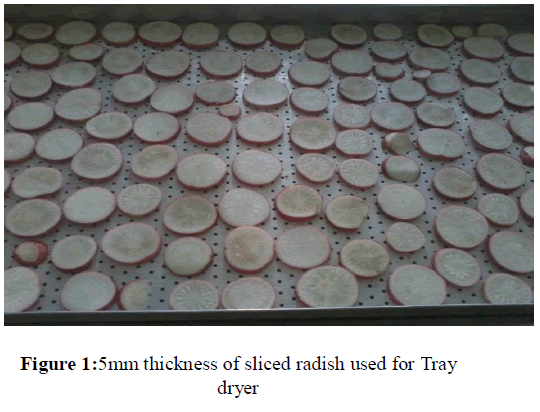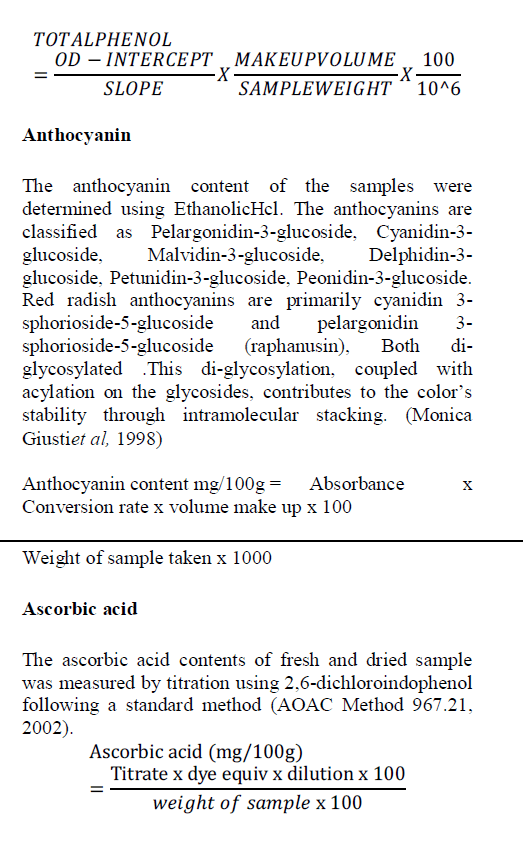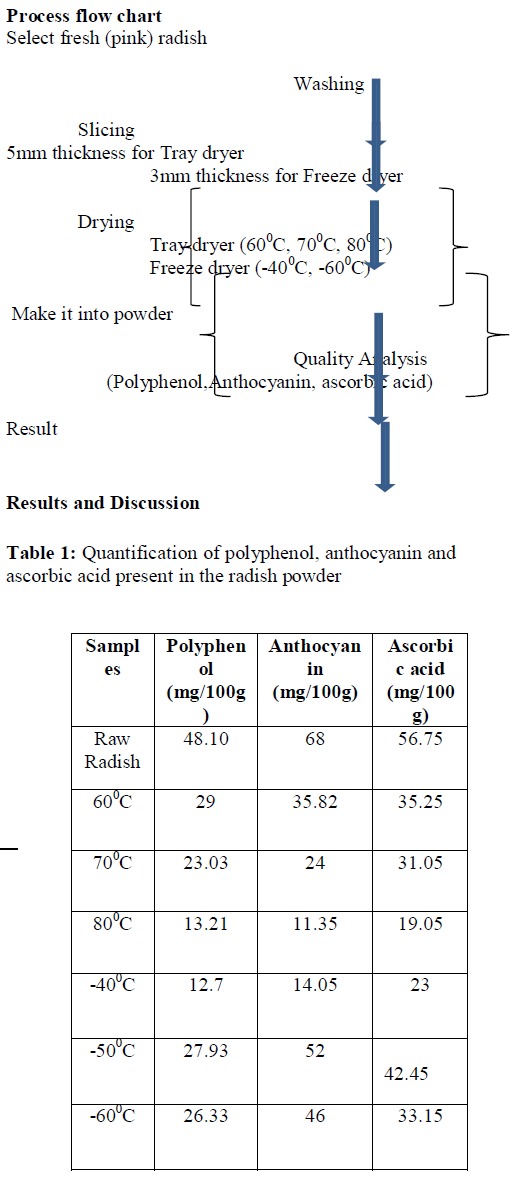ISSN ONLINE(2319-8753)PRINT(2347-6710)
ISSN ONLINE(2319-8753)PRINT(2347-6710)
S.Aruna1 and Dr. A. Nishadh2
|
| Related article at Pubmed, Scholar Google |
Visit for more related articles at International Journal of Innovative Research in Science, Engineering and Technology
The effect of thermal processing on pink coloured radish were determined using antray and freeze dryer at different temperatures (600C, 700C and 800C) and (-400C, -500C,-600C). The ascorbic acid content, polyphenol content and anthocyanin content were also measured from the fresh and dried radish. Thick slices (5mm) were made for tray dryer and thin slices (3mm) were made for freeze dryer. The moisture content (MC) decreased with drying temperature for both the thick and thin slices in each dryer. The retention of nutrient content was found decreased in the samples dried at higher temperature. The nutrient loss can be reduced by selection of proper temperature for drying. The antioxidant constituents in dried radish were decreased with higher temperature as compared with fresh sample. There was nohuge change on the ascorbic acid, polyphenol and anthocyanin contents of dried radish when dried at (600C ) in tray dryer and (- 500C) in freeze dryer. But there was about slight decrease in the ascorbic acid, polyphenol and anthocyanin content in radish after drying at different temperatures.
Keywords |
| radish, ascorbic acid, anthocyanin and polyphenol |
INTRODUCTION |
| Radish is a member of the Cruciferae (mustard family). Raphanussativusis a cool season annual (depending on when it is planted). Generally commercial radishes are approximately 2 cm in diameter and are either red or white. They reach market size in 21 to 28 days (or longer in cool weather). Radish varies in color from white to black.Radish is a quick growing cool season root vegetable. The seed will germinate in 3 to 4 days with soil temperatures of 18 to 30 °C with good moisture. The minimum temperature for germination is 5°C, the optimum temperature for germination is 300 C. The maximum temperature for germination is 350 C. Germination rates decline sharply when the soil temperature falls below 13°C. The best quality and root shape are obtained when the crop grows and matures at moderate temperatures (10 to 18 °C) in intermediate to short day lengths. |
| Radish remains in prime condition for only a few days. Roots of globe varieties tend to elongate and develop poor shape in hot weather when the tops also grow taller and larger than in cool weather. Long days induce flowering or seed stalks (bolting) and with warm weather the seed stalk may develop so rapidly that no edible root is formed. Radishes become more pungent in hot weather. Roots remain in marketable condition only a short time before becoming pithy. Growth must be continuous and rapid for good quality. Radish is a member of the Cruciferae (mustard family). Raphanussativus. Their fiber content of radishes is effective at preventing and fighting cancer.It also cures sinus infections or asthma. The fiber, vitamins and minerals in radishes cures heart diseases. And also reduces the cholesterol, manage diabetes and maintain blood pressure and blood sugar levels. Radish juice also prevents urinary tract infections (UTIs).Good source of Vitamin C, potassium and magnesium, Polyphenol, plus trace amounts of other nutrients, was mentioned by (Danica Collins, 2010). |
| Dehydration is a process that involves the application of heat to remove moisture from fresh fruit and vegetable products (Vega-Mercado et al., 2001; Jayaramanan& Das Gupta, 2006). Its primary objective is to reduce microbial activity and deterioration, and to extend the shelf life of the product.Other benefits of dehydration include reduction of weight, which greatly decreases the cost of packaging, handling, storage and transport (Singh &Heldman, 2009). |
| Drying is also an important step to produce dietary fiber powder. Although hot air drying is most commonly applied to produce dietary fiber powder, it is well recognized that this drying technique leads to much quality degradation, especially in terms of the functional properties of a product (Tanongkankitet al, 2010). The quality of dietary fiber powder, phenolics, vitamin C, β- carotene, α-tocopherol as well as the total antioxidant activity of the powder decreased quitesignificantly upon hot air drying. This is probably due to the lengthy required drying time and the oxygen-rich nature of the process (Kumar and Sagar2012). For this reason freezedrying could be an alternative for producing high-quality dietary fiber powder. (Chang et al,2006) reported that 90% of vitamin C was retained during freeze drying of tomato cubes, two-folds higher compared to hot-air drying.The present study was aimed at studying the evolution of various antioxidants in radish powder during traydrying (60°C, 70°C, 80°C)and freeze drying at (-40°C, -50°C,-60 °C). |
Materials and Method |
Chemicals |
| 10%Folins-Ciocalteau reagent, 7.5%Na2Co3, Standard Gallic acid solution, 1.5N EthanolicHcl in the ratio 85:15, 2, 6-dichlorophenolindophenol, Sodium bicarbonate (Analytical grade) |
Sample preparation |
| The pink radishes are purchased at local market. Radish with good quality and uniform size were washed under running water to remove dirts. Fruits and vegetable slicer is used for the cutting the radish in different sizes. In this research work the radish was cut into two sizes one is thick slices (5mm) for tray dryer and other one is thin slices (3mm) for freeze dryer. In tray dryer the radish (thick) slices were kept under different temperature (60°C, 70°C, 80°C). Whereas in freeze dryer the radish (thin) slices were kept under different temperature (-40°C, -50°C, -60°C) for drying. Mixer is used to grind the dehydrated slices to get powdered sample. |
Tray drying |
| The tray drying system used in this study consists of astainless steel drying chamber. The sample radish was sliced at 5mm thickness for tray dryer. The drying experiments were conducted at 60–80°C, which is a typical temperature range for drying of vegetables. Approximately 1kg of a sample was kept for drying; nearly 500g of sample was placed as a single layer on the tray. Drying was continued until the mass of the sample reached an equilibrium value and the dried sample was ground into fine powder and the same was stored in air tight containers. |
 |
Freeze drying |
| The freeze drying system used in this study where the water is removed by dehydration, through sublimation of ice in the materials.The sample radish was sliced at 3mm thickness for freeze dryer. The drying experiments were conducted at -40°Cto -60°C.Approximately 1kg of a sample was kept for drying, nearly 300g of sample was placed as a single layer on the tray. Drying was continued until the mass of the sample reached an equilibrium value. The dried sample was ground into fine powder and it was stored in an air tight containers for further analysis. |
 |
Polyphenol |
| The polyphenol content of the samples were determined using Folin–Ciocalteu reagent asdescribed by (Singleton & Rossi,1965). lmL ofsample is taken and 5ml of 10%Folin–Ciocalteuand 4ml of 7.5% sodium carbonate (Na2CO3) were added and allowed to react for 1hr at room temperature in dark. The absorbance was measured at 765 nm using spectrophotometers. A standard curve of gallic acid solution was prepared using the similar procedure. The results were expressed in mg/100 g of sample.(Marinovaet al, 2005) |
 |
 |
Determination of polyphenol |
| The values of polyphenol infresh and dried radish are shown in Table 1. The initial polyphenol content of fresh radish in 1ml sample is (48.10mg/100g), where in dried radishthe value for 1ml (29mg/100g) of tray dried radish powder at (60°C). In freeze dried radish powder the value of 1ml (27.93mg/100g) at (-50°C). It was observed that, thepolyphenol contents of radish decreases at higher temperature. |
Determination of anthocyanin |
| The values of anthocyanin infresh and dried radish are shown in Table 1. The initial anthocyanin content of fresh radish is (68 mg/100g). In dried radish, the value of tray dried radish powder at (60°C) is (35.82mg/100g) and the value of freeze dried radish powder at (-50°C) is (52mg/100g). It was observer that, thepolyphenol contents of radish decreases at higher temperature.Red radish anthocyanins are primarily cyanidin 3-sphorioside-5-glucoside and pelargonidin 3-sphorioside-5- glucoside(raphanusin),both di-glycosylated . This diglycosylation, coupled with acylation on the on the glycosides, contributes to the color’s stability to radish (Monica Giustiet al, 1998). It is observed that the higher temperature will affect this acylation that leads to loss of anthocyanin pigment in radish. |
Determination of ascorbic acid |
| The mean values of ascorbic acid of fresh and dried radish are shown in Table 1. The initial ascorbic acid content of fresh radish is (56.75 mg/100g) where thedried radish which encompassed the value of (35.25mg/100g)in tray dried powder at (60°C) and (42.45mg/100g) in freeze dried powder at (-50°C). The ascorbic acid contents of dried radish of temperature at (60°C and -50°C) were not significantly different from each other. This means that there was not much change in the ascorbic acid content of driedradish at these temperatures in tray and freeze dryer. But there was about 19% decrease in the ascorbic acid contents of dried radish after drying at (80°C) in tray dryer and (– 40°C) in freeze dryer. The difference observed was probably due to longer drying time The longer the drying time would result to more ascorbic acid degradation in the radish sample. |
CONCLUSION |
| A study has been carried out to determine the impact of thermal processing on the pigments and nutritional quality of radish. From the study, it has been identified that the thermal processing significantly affects these functional compounds at increasing temperature. The samples dried in tray drier at (60°C) and freeze drier at (-50°C) retained the compounds which is responsible for antioxidant activity. The loss of nutrients will occur only at higher temperature and also quality of the product mostly depends only on the selection of temperature for drying. The reduction in the antioxidants was observed in the samples dried at other temperatures (70°C, 80°C in Tray dryer and -40°C, - 60°Cin Freeze dryer) due to the difference in temperature and also time taken for drying. These results indicated the non-destructive effects of antioxidant at temperature (60°C) on tray dried and (- 50°C) on freeze dried radish powder. |
References |
|